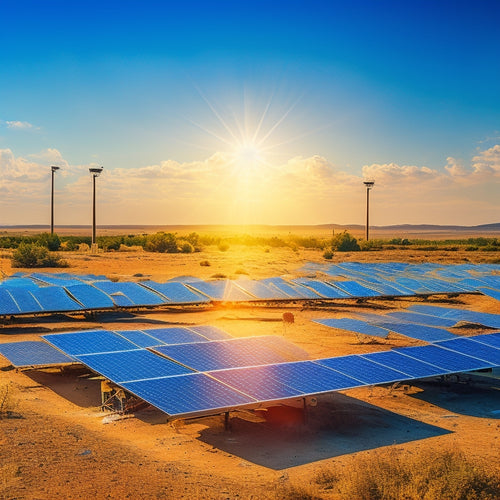
Renewable Energy's Role in Reducing Carbon Emissions
Share
Renewable energy plays an essential role in reducing carbon emissions by displacing fossil fuels with cleaner sources. By utilizing solar, wind, and hydro power, you're not only lowering your carbon footprint but also contributing to improved air quality and better health outcomes. Shifting to renewables helps create jobs and stimulates economic growth while nurturing community resilience. As these clean energy technologies advance, they become increasingly efficient, making them more accessible and cost-effective. This change is vital for sustainable practices and a healthier planet. Investigate how these innovations further impact our environment and future energy environment.
At a Glance
- Renewable energy reduces reliance on fossil fuels, significantly lowering carbon emissions and contributing to climate change mitigation.
- Transitioning to clean energy sources improves air quality, leading to better health outcomes and reduced respiratory issues in communities.
- Investment in renewable infrastructure creates jobs, stimulates local economies, and promotes resilience against market fluctuations.
- Utilizing technologies like smart grids and energy storage enhances the integration of renewables, ensuring reliability and efficiency in power supply.
- The adoption of solar, wind, and other renewable sources supports biodiversity and ecosystem restoration by minimizing pollution and habitat destruction.
Cost-Effective Long-Term Savings
By switching to renewable energy, you can greatly lower your energy bills over time.
Additionally, various investment incentives are available, making this change not only environmentally friendly but also financially savvy.
Analyzing these savings reveals the potential for considerable long-term benefits.
Lower Energy Bills
As you investigate renewable energy options, you'll likely find that changing to these sources can greatly reduce your energy bills over time. By utilizing solar, wind, or other renewable technologies, you can improve your energy efficiency, leading to significant cost savings.
For instance, solar panels generate electricity directly from sunlight, reducing your dependence on grid energy and lowering your monthly expenses.
Incorporating smart technology enhances these savings even further. Smart thermostats, for example, optimize your heating and cooling, ensuring that you're not wasting energy when you're not home. This level of control allows you to tailor your energy consumption, aligning it with your lifestyle and ultimately reducing costs.
Moreover, renewable energy systems often come with lower maintenance costs compared to traditional fossil fuel systems. As you invest in these technologies, you'll notice that your energy bills decrease, freeing up funds for other pursuits.
The shift to renewable energy isn't just about environmental benefits; it's a pathway to financial freedom. By adopting energy-efficient solutions and capitalizing on smart technology, you're not just reducing your carbon footprint, but also enabling yourself to take control of your financial future.
Investment Incentives Available
The financial benefits of renewable energy don't just stop at lower energy bills; various investment incentives can greatly enhance your savings. By leveraging tax credits and federal rebates, you can considerably reduce your upfront costs for solar panels and wind turbines. For instance, the federal solar tax credit allows you to deduct a percentage of your installation costs from your federal taxes, making solar energy more accessible.
Additionally, many states offer unique incentives, including grant programs and state-specific solar incentives that further lower the financial barrier. Wind subsidies can also provide substantial support if you're considering wind energy.
Investment partnerships in renewable projects can help you pool resources with like-minded individuals, maximizing your impact while minimizing personal financial risk. Renewable bonds are another option, allowing you to invest in clean energy projects that generate returns while supporting sustainability.
Moreover, financing options customized for energy efficiency upgrades can help you manage cash flow. By taking advantage of these incentives, you're not only investing in your own energy independence but also contributing to a broader shift toward sustainable living.
Embracing these options can lead to cost-effective, long-term savings.
Environmental Impact Reduction
By shifting to renewable energy, you greatly reduce your reliance on fossil fuels, which directly lowers carbon emissions. This change not only mitigates climate change but also enhances air quality, leading to improved health outcomes for communities.
Additionally, adopting technologies like solar panels can contribute to a substantial reduction in energy costs, promoting sustainable practices within households and businesses financial benefits.
As you welcome cleaner energy sources, the broader environmental benefits become increasingly clear and beneficial.
Decreased Fossil Fuel Dependence
Reducing fossil fuel dependence can greatly diminish environmental impacts, particularly regarding carbon emissions. By adopting fossil fuel alternatives like solar, wind, and hydroelectric power, you can actively participate in the change toward cleaner energy sources. This shift not only lessens your carbon footprint but also encourages a more sustainable future for everyone.
Implementing effective energy change strategies is essential. For instance, investing in energy efficiency measures and expanding renewable energy infrastructure can greatly reduce reliance on fossil fuels. When you accept these changes, you help decrease greenhouse gas emissions that contribute to climate change.
Moreover, the economic benefits of decreasing fossil fuel dependence are remarkable. The growth of renewable energy sectors creates jobs and stimulates local economies, offering you a chance to support community resilience. By prioritizing fossil fuel alternatives, you're not just making a personal choice; you're joining a larger movement toward environmental accountability.
Ultimately, your commitment to reducing fossil fuel reliance translates into a cleaner planet. By supporting renewable energy, you take an active role in shaping a healthier, more sustainable future for yourself and generations to come.
Enhanced Air Quality Benefits
Shifting to renewable energy sources not only cuts down on fossil fuel dependence but also leads to significant improvements in air quality. You'll notice that reducing air pollution has immediate health benefits, including fewer respiratory issues and improved overall well-being. As communities engage with sustainable practices, they can better advocate for urban planning that prioritizes green spaces and clean energy solutions.
Here's a closer look at the air quality benefits associated with renewable energy:
| Benefit | Impact on Air Quality | Related Factors |
|---|---|---|
| Reduced Emissions | Decreases pollutants | Energy evolution |
| Improved Health | Lowers respiratory issues | Community engagement |
| Economic Opportunities | Creates green jobs | Technology advancements |
| Enhanced Social Equity | Benefits all communities | Inclusive policies |
The shift to renewable energy is more than just an energy evolution; it promotes social equity by ensuring all communities can enjoy cleaner air. Embracing technology advancements in this field can further amplify these benefits, making air quality improvements a cornerstone of sustainable practices. Ultimately, your commitment to renewable energy can lead to a healthier, more equitable future.
Key Benefits of Renewable Energy
Renewable energy not only helps you reduce environmental impacts but also opens up significant economic growth opportunities.
By shifting to clean energy sources, you can lower carbon emissions while stimulating job creation in emerging industries.
Solar inverter solutions play a significant part in enhancing energy access in rural areas, further contributing to economic development.
This dual benefit positions renewable energy as an essential component of a sustainable future.
Environmental Impact Reduction
The shift to renewable energy sources plays an essential role in mitigating environmental impact. By converting to wind, solar, and hydroelectric power, you considerably reduce carbon emissions compared to fossil fuels. This reduction is fundamental in combating climate change and promoting cleaner air and water.
Implementing carbon offset strategies is another powerful way you can contribute to environmental protection. These strategies allow you to compensate for your carbon footprint by investing in projects that restore ecosystems, such as reforestation or wetland restoration. Such initiatives not only absorb carbon dioxide but also enhance biodiversity and support wildlife habitats.
Moreover, the use of renewable energy encourages ecosystem restoration. By minimizing pollution and habitat destruction caused by traditional energy sources, you help maintain the delicate balance of natural environments. This balance is essential for sustaining life and ensuring natural resources are available for future generations.
In essence, embracing renewable energy isn't just about reducing your carbon footprint; it's about taking active steps toward healing the planet. Every effort you make in this direction helps create a sustainable future, where both people and ecosystems can thrive.
Economic Growth Opportunities
Utilizing renewable energy sources can release significant economic growth opportunities. By investing in sustainable industries, you'll see job creation across various sectors, from solar panel manufacturing to wind turbine installation.
This surge in employment not only stimulates local economies but also nurtures economic resilience against market fluctuations.
Technology innovation plays a critical role here. As new renewable technologies emerge, they drive efficiency and reduce costs, making energy independence a viable goal for many communities.
You'll find that green entrepreneurship thrives in this environment, with startups focused on clean energy solutions and circular economy practices gaining traction.
Workforce development initiatives become essential as you educate and train individuals for these emerging opportunities.
Regional investments in renewable infrastructure further enhance community engagement, creating a sense of ownership and satisfaction among residents.
Assessing Energy Source Compatibility
When evaluating energy source compatibility, it's essential to contemplate how well different renewables can integrate into existing infrastructure.
You'll find that some sources, like solar and wind, may require considerable adjustments to the grid to optimize their efficiency.
For instance, high-efficiency solar panels can greatly enhance energy production, making them an important part of this shift.
Understanding these interactions helps guarantee a seamless changeover to cleaner energy without compromising reliability.
Energy Source Integration
Many energy systems today rely on a diverse mix of sources to guarantee reliability and efficiency. This integration is essential for successful energy evolution strategies, as it helps balance supply and demand while minimizing carbon emissions.
However, you'll face grid integration obstacles when combining renewable sources like solar and wind with traditional fossil fuels. These challenges arise due to the intermittent nature of renewables, which can lead to fluctuations in energy output.
To overcome these obstacles, you can adopt various solutions, such as improving energy storage technologies and enhancing grid infrastructure.
For instance, advanced battery systems can store excess energy generated during peak production times, ensuring that power is available even when the sun isn't shining or the wind isn't blowing. Additionally, smart grid technologies can optimize energy distribution, making it easier to manage varying energy inputs and outputs.
Compatibility With Infrastructure
Evaluating the compatibility of renewable energy sources with existing infrastructure is essential for a successful shift to a low-carbon future. You need to contemplate how current systems can adapt to accommodate energy sources like solar and wind.
Grid adaptation plays a vital role in this change, as it guarantees that renewable energy can be efficiently integrated into the existing power network. Without significant infrastructure upgrades, the full potential of renewables may remain untapped.
You'll find that older grids often struggle to manage the variability of renewable sources, leading to potential inefficiencies and outages. Upgrading these systems isn't just about capacity; it's about enhancing resilience and reliability.
Moreover, proactive planning can ease the financial burden of these upgrades, making renewable energy more accessible. You'll want to advocate for smart grid technologies that facilitate real-time data management and energy distribution.
Ultimately, the compatibility of renewable energy with existing infrastructure hinges on your commitment to nurturing innovation and investment in grid adaptation. By prioritizing these changes, you can help pave the way for a more sustainable energy environment, enabling communities to achieve their freedom from fossil fuel dependency.
Lower Greenhouse Gas Emissions
When you consider clean energy sources, it's clear they play an essential role in reducing greenhouse gas emissions.
By moving to renewables like solar, wind, and hydro, you can greatly lower your carbon footprint.
This change not only benefits the environment but also promotes long-term sustainability in energy consumption.
Clean Energy Sources
Amid the urgent need to combat climate change, clean energy sources emerge as essential players in reducing greenhouse gas emissions.
You might find solar power and wind energy leading the charge, utilizing natural elements to produce energy without the harmful byproducts of fossil fuels. Both technologies have become increasingly efficient, showcasing significant advancements in renewable technologies.
Consider hydropower potential, which utilizes water flow to generate electricity, offering a reliable and eco-friendly alternative.
On the other hand, biomass advantages lie in utilizing organic materials, contributing to carbon neutrality while promoting sustainable practices.
Geothermal benefits also deserve attention, drawing on Earth's heat for energy, providing a consistent power source with a minimal carbon footprint.
Frequently Asked Questions
How Does Renewable Energy Affect Job Creation in Different Sectors?
You'll see job diversity increase as sectors evolve through renewable energy. This shift drives economic growth and nurtures skill development, creating opportunities across industries. Embracing these changes enables you and your community towards a sustainable future.
What Are the Challenges in Transitioning to Renewable Energy Sources?
Did you know that 70% of energy storage projects face funding challenges? Shifting to renewable energy requires significant infrastructure investment, which can hinder progress. Balancing costs and technology needs remains a major hurdle for achieving sustainable energy solutions.
How Can Individuals Contribute to Renewable Energy Adoption?
You can contribute to renewable energy adoption through personal initiatives like installing solar panels and engaging your community by organizing awareness campaigns. These actions enable others, nurturing collective responsibility towards sustainable practices and a healthier environment.
What Is the Role of Technology in Advancing Renewable Energy Efficiency?
Technology's like a sculptor, shaping renewable energy's future. Smart grids enhance distribution, energy storage captures potential, solar innovation and wind technology drive progress, while efficiency optimization and sustainable materials create a harmonious balance for your freedom.
How Do Government Policies Influence Renewable Energy Development?
Government policies shape renewable energy development through subsidy programs and financial incentives, influencing market competition. Regulatory structures and international agreements promote innovation, while public awareness drives demand, ensuring you benefit from a thriving, sustainable energy future.
Explore More
In embracing renewable energy, you're not just investing in cost-effective solutions; you're also planting the seeds for a sustainable future. By reducing greenhouse gas emissions, you're helping to cool our planet, like a gust of fresh air in a stuffy room. The compatibility of these energy sources with existing systems guarantees a smoother shift. Ultimately, your choice to prioritize renewables can lead to significant long-term savings while actively contributing to a healthier environment for generations to come.
Related Posts
-

What Happens Without a Charge Controller in Solar Panels
Without a charge controller in your solar panel system, you risk overheating batteries due to overcharging, which can...
-

Why Outdoor Solar Lighting Systems Are Sustainable
Outdoor solar lighting systems are sustainable because they utilize renewable energy, drastically reducing your carbo...
-

Smart Grid Technology Implementation Challenges
You'll encounter several challenges when implementing smart grid technology, particularly in cost management, scalabi...


